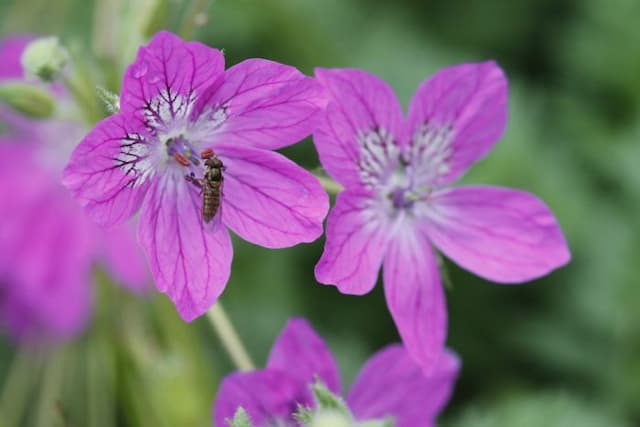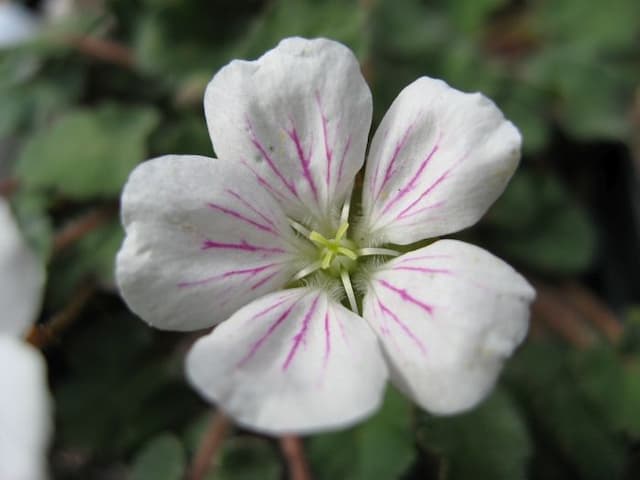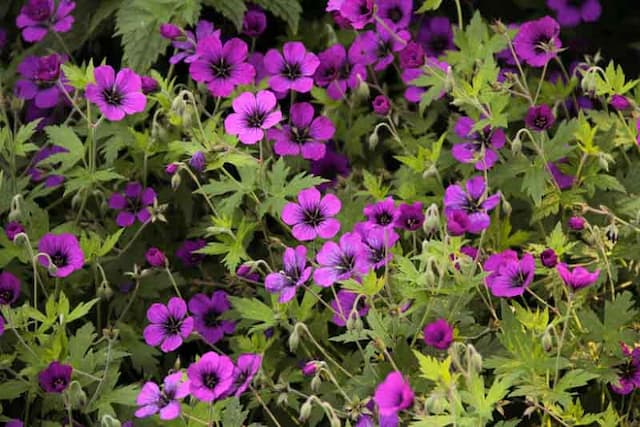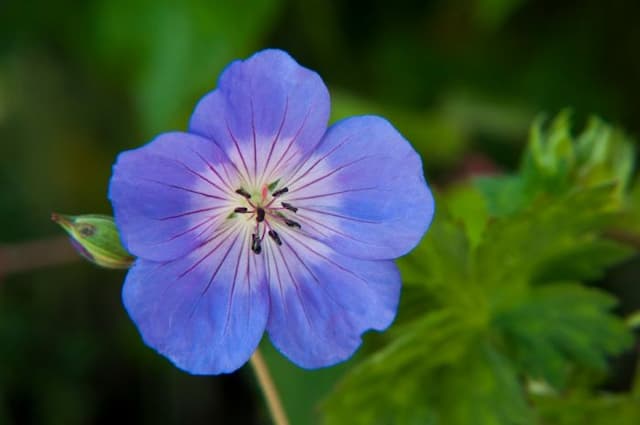Geranium Geranium 'Sweet Heidy' (PBR)

ABOUT
Geranium 'Sweet Heidy' is a visually appealing perennial plant known for its decorative foliage and delightful blooms. The plant showcases rounded leaves that carry a soft, velvety texture, often with distinct zonal patterns in shades of green. It is the flowers, however, that draw the most attention. They are characterized by a striking color palette usually ranging from hues of pink to lavender with an enchantingly patterned throat marking, which can be of a deeper color or contrasting shade. The blossoms are composed of five petals, each with a rounded shape that contributes to the overall circular form of the flower. Flowers cluster together, forming a sphere-like shape that floats above the foliage on strong stems. These flowers are known to attract pollinators like bees and butterflies, adding a dynamic element to its display. The plant maintains a neat and compact appearance, making it a popular choice for borders, containers, and garden beds where its ornamental qualities can be showcased.
About this plant
 Names
NamesFamily
Geraniaceae.
Synonyms
Geranium 'Sweet Heidy', Cranesbill 'Sweet Heidy'.
Common names
Geranium 'Sweet Heidy' (PBR)
 Toxicity
ToxicityTo humans
Geraniums, including the 'Sweet Heidy', are not considered highly toxic to humans. Generally, ingestion of geranium leaves or flowers may cause mild gastrointestinal upset such as vomiting or diarrhea if consumed in significant amounts. However, they are not known to cause severe poisoning or life-threatening symptoms in humans if touched or ingested.
To pets
Geraniums, including the 'Sweet Heidy', can be toxic to pets, especially cats and dogs. If ingested, they may cause symptoms like vomiting, depression, dermatitis, or anorexia. Cats may also suffer from skin irritation upon contact. In serious cases, ingestion may lead to more significant health issues, so it is advisable to keep these plants out of reach of pets and monitor for any signs of distress if they are suspected to have come into contact with the plant.
 Characteristics
CharacteristicsLife cycle
Perennials
Foliage type
Deciduous
Color of leaves
Green
Flower color
Mixed
Height
1 foot 6 inches (46 cm)
Spread
1 foot (30 cm)
Plant type
Herb
Hardiness zones
5
Native area
Southeastern Europe
Benefits
 General Benefits
General Benefits- Attracts Pollinators: Invites beneficial insects like bees and butterflies, promoting biodiversity in the garden.
- Low Maintenance: Requires minimal care once established, making it ideal for busy gardeners or those with limited time.
- Drought Tolerant: Once established, it has a high tolerance for dry conditions, making it suitable for water-wise gardens.
- Long Bloom Period: Offers a long flowering season providing continuous color and interest in the garden.
- Ornamental Appeal: Features distinctive and colorful blooms that enhance the visual appeal of garden spaces.
- Versatile Landscaping: Suitable for borders, ground cover, containers, and hanging baskets, offering versatile gardening options.
- Deer Resistant: Less likely to be browsed by deer, reducing the need for protective measures in areas with deer populations.
- Fragrance: Provides a pleasant scent that can add another layer of enjoyment to garden experiences.
 Medical Properties
Medical PropertiesThis plant is not used for medical purposes.
 Air-purifying Qualities
Air-purifying QualitiesThis plant is not specifically known for air purifying qualities.
 Other Uses
Other Uses- As a natural dye: Geranium 'Sweet Heidy' can be used to create a variety of subtle dyes for fabrics, wool, and paper, resulting in hues ranging from soft greens to purples, depending on the mordant used.
- Insect repellent: The aromatic foliage of the geranium can be placed in areas where insects frequent, as the scent can deter them without the use of chemical repellents.
- Edible decoration: The flowers of Geranium 'Sweet Heidy' are edible and can be used to add a splash of color and a slightly tangy flavor to salads, desserts, and drinks.
- Mood enhancer: Having Geranium 'Sweet Heidy' around the home can uplift spirits and reduce stress levels due to its vibrant flowers and pleasant foliage.
- Artistic inspiration: Artists can use the Geranium 'Sweet Heidy' as a subject for paintings, drawings, or photography, capturing its unique color and form.
- Homemade potpourri: Dried leaves and petals of Geranium 'Sweet Heidy' can be incorporated into potpourri mixes to give a natural, pleasant aroma to interior spaces.
- Culinary experimentation: The leaves can be infused in syrups or sugars to create unique flavors for culinary use in baking or beverage mixing.
- Sachets and pouches: Dried geranium flowers and leaves can be placed in fabric sachets to freshen up drawers and closets.
- Learning tool: Geranium 'Sweet Heidy' can be used in educational settings, such as schools or botanical workshops, to teach about plant care, propagation, and horticulture.
- Eco-friendly confetti: Petals of the Geranium 'Sweet Heidy' can be used as a biodegradable alternative to traditional confetti for celebrations and eco-friendly events.
Interesting Facts
 Feng Shui
Feng ShuiThe Geranium is not used in Feng Shui practice.
 Zodiac Sign Compitability
Zodiac Sign CompitabilityThe Geranium is not used in astrology practice.
 Plant Symbolism
Plant Symbolism- Friendship: Geraniums are often thought to symbolize close bonds and friendship due to their long-lasting nature and pleasant appearance.
- Health: The geranium plant is sometimes associated with good health and a symbol of wellness, potentially because of their use in traditional medicine.
 Water
WaterHardy geraniums, such as 'Sweet Heidy', typically require moderate watering. They prefer soil that is consistently moist but well-drained, so it is crucial to avoid overwatering which can lead to root rot. Water these geraniums deeply once a week, providing about 1 inch of water which roughly translates to 0.6 gallons per square foot. During hot or dry spells, you may need to water them more frequently, possibly twice a week, to maintain sufficient moisture levels.
 Light
LightHardy geraniums, including 'Sweet Heidy', thrive best in full sun to partial shade. They should receive at least 4-6 hours of sunlight each day. The optimal spot for 'Sweet Heidy' geraniums is a location where they can enjoy morning sunlight and are protected from the intense heat of the afternoon sun, which can sometimes be too harsh.
 Temperature
Temperature'Sweet Heidy' geraniums are quite adaptable to temperature variations and can survive a range. However, they perform best within the temperature range of 65 to 75 degrees Fahrenheit. These hardy plants can tolerate minimum temperatures down to around 30 degrees Fahrenheit, which allows them to withstand light frost. They should be protected from temperatures that exceed 80 degrees Fahrenheit as higher temperatures can stress the plants.
 Pruning
PruningPruning 'Sweet Heidy' geraniums is important to encourage bushy growth and to remove any spent flowers or dead foliage, which helps prevent disease and promotes continuous blooming. Prune these geraniums in early spring or after they have flowered. Cutting back the plant by about one-third can stimulate new growth and flower production. Deadheading, or removing old blooms, should be done regularly throughout the blooming season.
 Cleaning
CleaningAs needed
 Soil
SoilGeraniums prefer a well-draining soil mix with equal parts peat, perlite, and potting soil. The ideal pH for geranium 'Sweet Heidy' is between 6.0 and 7.0, slightly acidic to neutral.
 Repotting
RepottingGeranium 'Sweet Heidy' should be repotted every one to two years to replenish nutrients and prevent root-bound conditions. Spring is the best time to repot this plant.
 Humidity & Misting
Humidity & MistingGeranium 'Sweet Heidy' thrives best in average home humidity levels. No special humidity adjustments are necessary for its growth.
 Suitable locations
Suitable locationsIndoor
Place 'Sweet Heidy' in bright, indirect light and water when topsoil dries.
Outdoor
Grow in partial shade to full sun, in moist, well-drained soil.
Hardiness zone
5-9 USDA
 Life cycle
Life cycleThe Geranium 'Sweet Heidy' (PBR) begins its life cycle as a seed, which, once sown in well-draining soil and provided with adequate warmth and moisture, will germinate. The seedling stage is marked by the emergence of the plant's first true leaves, after which it enters a vegetative growth phase where foliage expands and the root system strengthens. When mature and given sufficient light and nutrients, it initiates the flowering stage, producing distinctive blooms that can be pink, blue, or purple, attracting pollinators for sexual reproduction. After pollination, the plant forms seeds, completing its reproductive cycle. In temperate climates, the geranium may die back in winter and reemerge in spring, or it might require overwintering indoors as it is not frost-hardy. With proper care, 'Sweet Heidy' can live for several years, continually going through cycles of growth, flowering, and dormancy.
 Propogation
PropogationPropogation time
Spring-Summer
Propogation: Geranium 'Sweet Heidy' (PBR), commonly known as cranesbill, is most commonly propagated through cuttings. The ideal time to take cuttings for propagation is during late spring or early summer when the plant is actively growing. To propagate by cuttings, a sharp, clean knife or scissors is used to take a 3-4 inch (7.5-10 cm) stem cutting just below a leaf node. The lower leaves are removed, and the cut end of the stem is dipped in rooting hormone to encourage root development. This treated cutting is then inserted into a pot filled with moist, well-draining potting mix. The pot should be placed in a bright, indirect light location and kept at a consistent moisture level, but not waterlogged. Roots typically develop in a few weeks, after which the new plants can be transplanted into individual pots or directly into the garden.







![Cranesbill [Rothbury Gem]](/_next/image?url=https%3A%2F%2Fplants-admin.emdemapps.com%2Fimages%2Fplants%2F%2Fimages%2F604b6243984c2.png&w=640&q=75)

